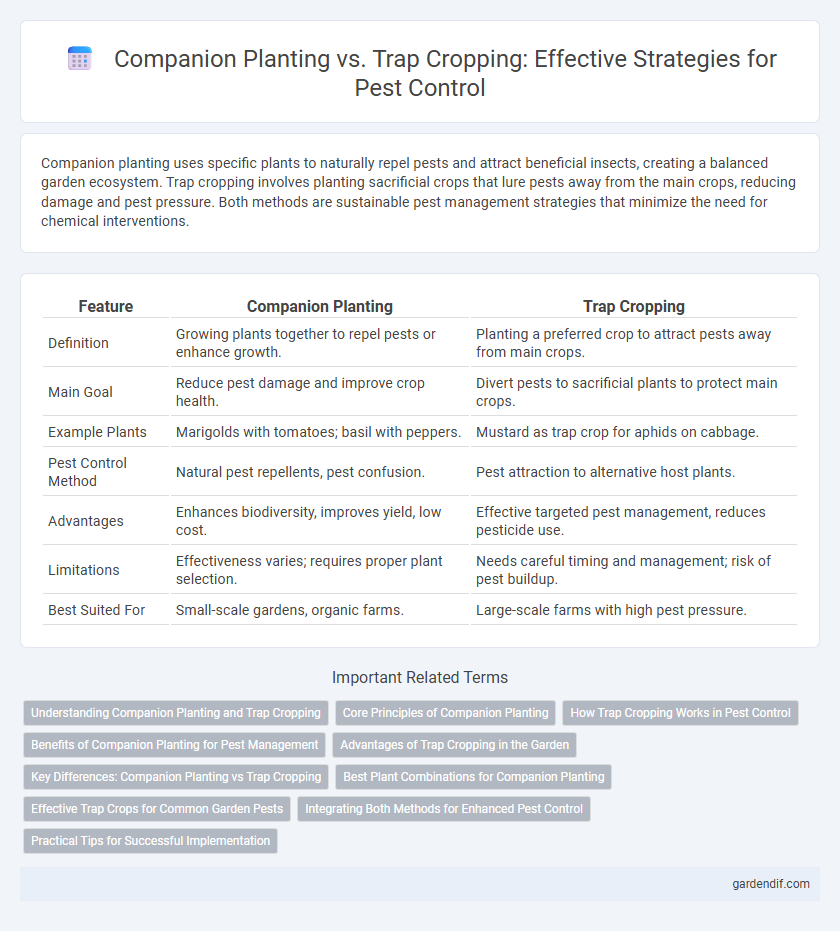
Companion Planting vs Trap Cropping Illustration
Companion planting uses specific plants to naturally repel pests and attract beneficial insects, creating a balanced garden ecosystem. Trap cropping involves planting sacrificial crops that lure pests away from the main crops, reducing damage and pest pressure. Both methods are sustainable pest management strategies that minimize the need for chemical interventions.
Table of Comparison
| Feature | Companion Planting | Trap Cropping |
|---|---|---|
| Definition | Growing plants together to repel pests or enhance growth. | Planting a preferred crop to attract pests away from main crops. |
| Main Goal | Reduce pest damage and improve crop health. | Divert pests to sacrificial plants to protect main crops. |
| Example Plants | Marigolds with tomatoes; basil with peppers. | Mustard as trap crop for aphids on cabbage. |
| Pest Control Method | Natural pest repellents, pest confusion. | Pest attraction to alternative host plants. |
| Advantages | Enhances biodiversity, improves yield, low cost. | Effective targeted pest management, reduces pesticide use. |
| Limitations | Effectiveness varies; requires proper plant selection. | Needs careful timing and management; risk of pest buildup. |
| Best Suited For | Small-scale gardens, organic farms. | Large-scale farms with high pest pressure. |
Understanding Companion Planting and Trap Cropping
Companion planting enhances pest control by growing specific plant combinations that repel harmful insects or attract beneficial predators, promoting a balanced ecosystem in the garden. Trap cropping involves planting sacrificial crops that lure pests away from the main crops, effectively reducing pest damage. Both methods optimize natural pest management by minimizing the need for chemical interventions and improving crop health.
Core Principles of Companion Planting
Companion planting relies on the strategic placement of specific plants to naturally repel pests, attract beneficial insects, and enhance crop growth through mutual support. Core principles include selecting plant combinations that improve soil nutrients, deter harmful insects, and encourage pollinators, creating a balanced ecosystem in the garden. This method emphasizes biodiversity and plant interactions to reduce pest damage without chemical interventions.
How Trap Cropping Works in Pest Control
Trap cropping attracts pests away from the main crops by planting specific sacrificial plants that lure insects, effectively concentrating pests in a controlled area. These trap plants intercept pest populations, reducing damage and lowering the need for chemical pesticides on the primary crop. This strategy leverages pest behavior and host plant preferences to enhance sustainable pest management in agriculture.
Benefits of Companion Planting for Pest Management
Companion planting enhances pest management by attracting beneficial insects that naturally prey on pests, reducing the need for chemical pesticides. It improves plant health and resilience through nutrient sharing and microclimate modifications, which lowers pest infestations. This ecological approach promotes biodiversity, supporting a balanced ecosystem that suppresses pest populations effectively.
Advantages of Trap Cropping in the Garden
Trap cropping attracts pests away from main crops by using specific plants that pests prefer, reducing the need for chemical pesticides. This method enhances pest management by localizing infestations, making it easier to target and eliminate pests. Trap cropping also promotes biodiversity and supports beneficial insect populations, improving overall garden health.
Key Differences: Companion Planting vs Trap Cropping
Companion planting involves growing specific plants together to naturally repel pests or enhance growth, while trap cropping uses sacrificial plants to lure pests away from the main crop. Companion planting promotes biodiversity and pest resistance within the crop area, whereas trap cropping concentrates pest damage on non-valuable plants, protecting the primary harvest. Both methods reduce reliance on chemical pesticides but differ in their ecological approach and pest management strategy.
Best Plant Combinations for Companion Planting
Tomatoes thrive when planted with basil and marigold, as these companions deter pests like aphids and whiteflies effectively. Beans benefit from being paired with corn and squash, forming the traditional "Three Sisters" trio that enhances growth and repels insects naturally. Nasturtiums act as both a trap crop and a companion, attracting aphids away from valuable vegetables such as cucumbers and cabbage, reducing pest damage without chemical intervention.
Effective Trap Crops for Common Garden Pests
Effective trap crops such as mustard and nasturtium attract aphids away from main vegetables, reducing pest damage in companion planting systems. Marigolds serve as trap crops for nematodes and whiteflies, protecting tomatoes and peppers by diverting pests. Utilizing trap cropping with species like dill helps manage caterpillar infestations, enhancing overall garden health and yield.
Integrating Both Methods for Enhanced Pest Control
Integrating companion planting and trap cropping maximizes pest control by combining pest-repellent and pest-attractant plant species within the same garden ecosystem. Companion plants such as marigolds deter harmful insects, while trap crops like mustard plants lure pests away from primary crops, reducing damage and minimizing pesticide use. This strategic integration enhances biodiversity, supports natural predator populations, and promotes sustainable agriculture by maintaining ecological balance.
Practical Tips for Successful Implementation
Companion planting involves growing complementary plants together to naturally repel pests and enhance growth, such as planting marigolds near tomatoes to deter nematodes. Trap cropping requires cultivating sacrificial plants like mustard greens at field edges to lure pests away from main crops, effectively reducing pest pressure. For successful implementation, select pest-specific companion or trap crops suited to your region, monitor pest activity regularly, and integrate with other pest management practices for optimal results.
Companion Planting vs Trap Cropping Infographic

 gardendif.com
gardendif.com